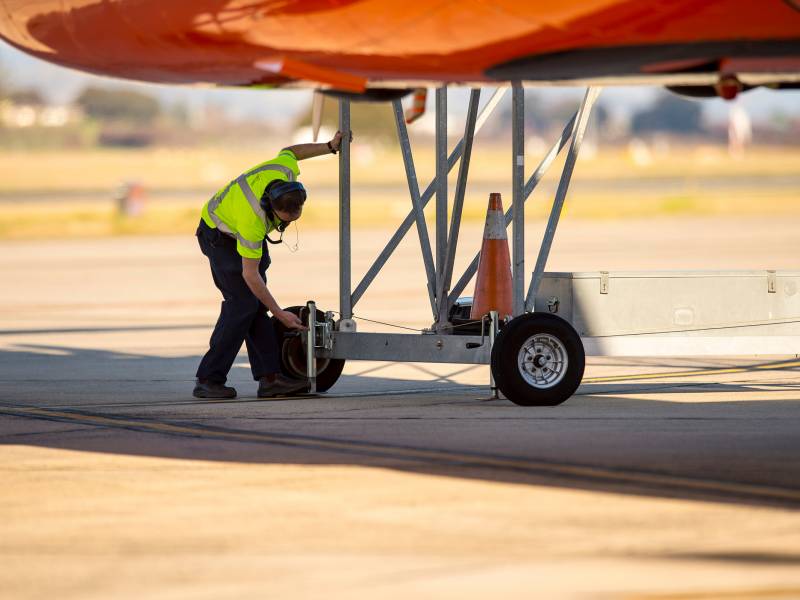Provide a Safe Workplace for all Users
Launceston Airport (APAL) and its tenants engage Contractors to perform a variety of different tasks from time to time. It is of the utmost importance to ensure that we provide a safe workplace for Contractors and that they are fully aware of all the relevant safety, environment and operational requirements at the airport. This will ensure that we can maintain the safety and integrity of the airport, the environment and all airport users.
Safety is the priority
Launceston Airport (APAL) and our tenants work with Contractors to help us carry out a variety of important tasks. Keeping everyone safe is our top priority, so it’s essential that all Contractors are aware of the safety, environmental, and operational guidelines in place at the airport.
By working together and following these requirements, we can make sure the airport remains a safe and well-managed environment for everyone — including staff, contractors, and all who pass through.
Your Airport Induction
Launceston Airport requires all contractors to complete a Safety, Security, and Environment Induction. This Induction is designed to give you a clear understanding of how the Airport operates and what safety requirements need to be followed while you're here.
It’s important for anyone working at or near the airport — whether you’re in a customer-facing business, working close to the airfield perimeter, or within the general airport area.
The induction is a required step to make sure everyone stays safe and informed while on site.
The documents below explain the contractor management procedure at Launceston Airport.
Contractor Engagement Requirements
These requirements shall be achieved by:
Contractor Monthly Reporting
External Contractors/third parties are required to lodge two monthly reports - The Monthly Safety Report and The Monthly Environmental/Waste Report.
The Monthly Safety Report (to the APAC Safety team) reporting on the number and types of incidents over the past 30 days (Lagging Indicators) and number of Safety Inspections planned, hazards reported, closed out, etc (Leading Indicators).
Please use the forms below to report an Incident or Hazard identified at Launceston Airport and to report construction and demolition waste.
Contractor Monthly Safety Report
Contractor Monthly Environmental Waste Report
Once completed, please email both reports to [email protected]
Incident/Hazard Public Form
This form is for all airport users including the general public, external contractors and third-party operators to log safety incidents, positive safety interventions and hazards identified at Launceston Airport.
Use the form below to report an Incident or Hazard identified at Launceston Airport
Before Starting Work at Launceston Airport
The following steps will need to be followed for a contractor to begin work at Launceston Airport. Please review the following document and follow the appropriate steps.
Contractor Engagement Requirements
Before you begin any work at Launceston Airport, please take a moment to meet with the person who assigned you the job. They’ll walk you through the work area, what kind of access you’ll need, and any other important details to help you get started safely and confidently.
As a contractor, it’s essential that you review the APAL Technical Standards, Guidelines, and procedures, alongside any relevant Australian Standards. Depending on the nature of your work, there may be additional requirements to meet.
If your work takes you airside or into a secure (sterile) area, you’ll need a valid ASIC (Aviation Security Identification Card) or a VIC (Visitor Pass). Your Airport contact can advise of your specific access requirements.
Some projects may also require Planning Approval before we can begin processing a Building Approval.Taking the time to go through this information will help make your work at Launceston Airport safer, easier, and fully compliant with all regulations.
Before You Start Work
1. Let Us Know Before You Arrive
Contractors must give at least 24 hours’ notice before starting any work at the airport. When you notify us, please include a brief description of the work you’ll be doing and where it will be located.You can notify us by phone or email — we’re here to help.
2. Complete the Online Induction & Provide Insurance Details
All contractors must complete an online Launceston Airport Worker Induction before starting any work — this includes work inside buildings or anywhere within the airport precinct (landside, airside, sterile, or restricted areas). We also require a copy of your business insurance to be submitted during this process.
What's New?
We’ve simplified things! The new Launceston Airport Worker Induction replaces the previous WHSE and Restricted Access inductions. It’s a combined program and takes about 15–20 minutes to complete.
It includes:
- 5 short presentations
- 5 quick assessments
- 2 document reviews
You can complete it in one sitting, or save at the end of a module and return later.
Note: The APAL Contractor Registration and DAMP induction processes remain unchanged.
How to Get Started
✅ Step 1: Register Your Business
The first person from your company must register your business info (including insurance details) here: 👉 Register Your Business
After uploading your info, scroll to the bottom and click “Complete Induction.”
✅ Step 2: Complete the Induction
Once your business is registered, individual team members can then complete the induction👉 Start Your Induction
3. Submit a Safety Risk Assessment
Every job carried out at Launceston Airport must include a risk assessment, such as a JSA (Job Safety Analysis) or SWMS (Safe Work Method Statement).Your risk assessment must be specific to the work being done on site and will be reviewed during your on-site approval process.
Questions or Need Help?
If you have any questions or need to discuss your upcoming work, don’t hesitate to contact the Launceston Airport team — we’re happy to help you get set up.1. Provide notice to Launceston Airport:
Contractor Permits
There are two types of permits used by Launceston Airport:
- A Permit to Work (PTW) –this permit is the overarching risk management process. Depending upon the scope of work an additional Works Authority (Section 1.1) may also be required.
- Works Authorities – these authorities are applicable to specific risks. Such as working at heights or confined space entry. Works Authorities may not be issued without a PTW.
Launceston Airport has implemented an electronic Permit and Works Authority application and approval system
The system, Dashpivot by Sitemate, allows contractors, external project managers and APAL staff to create and track permits and authorities.
It is web based and an App is available to create and track Permits on the go.
Apply for Works Permits & Authorities
Dashpivot is where you can apply and track Works Permits & Authorities.
To get started, email [email protected] to register as a system user and include the following information
- Your name and email address
- Who is engaging you at Launceston Airport
- The type of work you will be doing here, based on the types listed below
- Project work including project name
- APAL maintenance work
- External party/tenant works eg. Air Services, food and beverage providers, baggage handling services
Once you have been registered as a user you will receive an email from Dashpivot asking you to complete the user profile setup.
You’re now ready to start using the system.
Download the Dashpivot User Guide to get started and apply for a permit.
Review the Safe Works Permit Procedure to understand your requirements.


